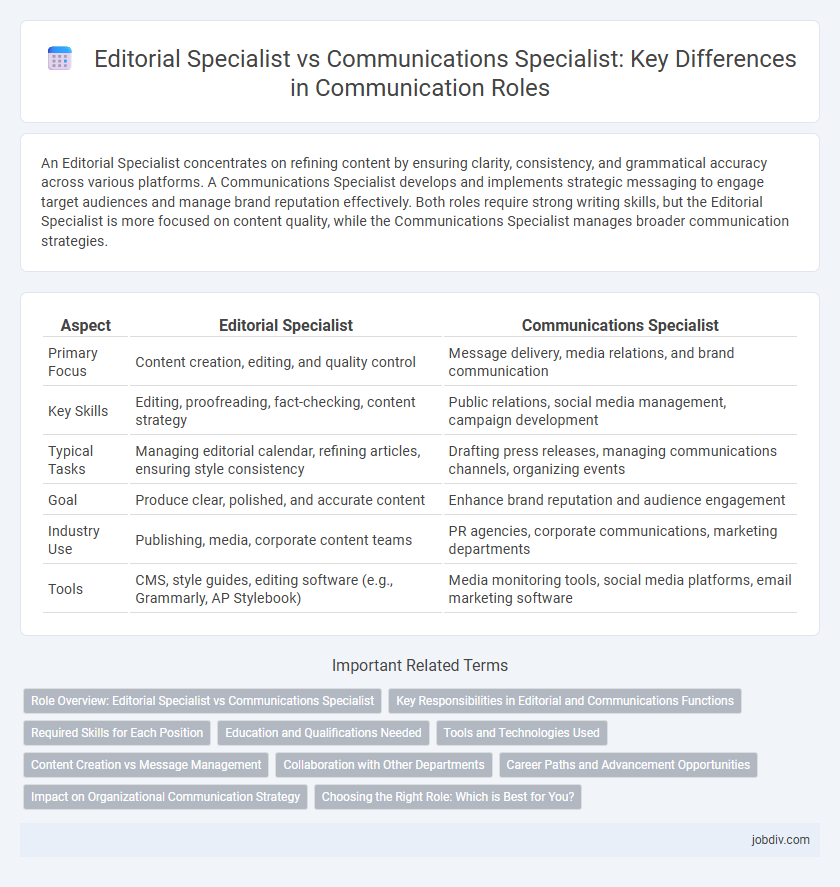An Editorial Specialist concentrates on refining content by ensuring clarity, consistency, and grammatical accuracy across various platforms. A Communications Specialist develops and implements strategic messaging to engage target audiences and manage brand reputation effectively. Both roles require strong writing skills, but the Editorial Specialist is more focused on content quality, while the Communications Specialist manages broader communication strategies.
Table of Comparison
| Aspect | Editorial Specialist | Communications Specialist |
|---|---|---|
| Primary Focus | Content creation, editing, and quality control | Message delivery, media relations, and brand communication |
| Key Skills | Editing, proofreading, fact-checking, content strategy | Public relations, social media management, campaign development |
| Typical Tasks | Managing editorial calendar, refining articles, ensuring style consistency | Drafting press releases, managing communications channels, organizing events |
| Goal | Produce clear, polished, and accurate content | Enhance brand reputation and audience engagement |
| Industry Use | Publishing, media, corporate content teams | PR agencies, corporate communications, marketing departments |
| Tools | CMS, style guides, editing software (e.g., Grammarly, AP Stylebook) | Media monitoring tools, social media platforms, email marketing software |
Role Overview: Editorial Specialist vs Communications Specialist
Editorial Specialists concentrate on crafting, editing, and refining written content to ensure clarity, consistency, and adherence to brand voice across various platforms. Communications Specialists develop and implement strategic communication plans, manage media relations, and facilitate internal and external messaging to enhance organizational reputation. Both roles require strong writing skills, but Editorial Specialists emphasize content quality and style, while Communications Specialists focus on message dissemination and stakeholder engagement.
Key Responsibilities in Editorial and Communications Functions
Editorial Specialists focus on content creation, editing, and ensuring consistency in tone and style across publications, managing deadlines and coordinating with writers to produce polished materials. Communications Specialists develop and implement strategic communication plans, handle media relations, and manage internal and external messaging to enhance organizational reputation. Both roles require strong writing skills, but Editorial Specialists emphasize content quality, while Communications Specialists prioritize message delivery and audience engagement.
Required Skills for Each Position
Editorial Specialists must excel in content editing, grammar, and style consistency, with strong attention to detail and expertise in proofreading and fact-checking. Communications Specialists require skills in strategic messaging, public relations, media outreach, and crisis communication, alongside proficiency in digital communication tools and social media management. Both roles demand excellent writing abilities, but the Editorial Specialist emphasizes content refinement, while the Communications Specialist focuses on audience engagement and brand messaging.
Education and Qualifications Needed
Editorial Specialists typically require a bachelor's degree in English, Journalism, or Communications, with strong skills in content editing, proofreading, and understanding of style guides such as AP or Chicago Manual of Style. Communications Specialists often hold degrees in Communications, Public Relations, or Marketing, emphasizing strategic messaging, media relations, and digital content creation. Both roles benefit from experience in content management systems and strong written communication abilities, but Communications Specialists may also need expertise in social media and analytics tools.
Tools and Technologies Used
Editorial specialists primarily use content management systems (CMS) like WordPress, Adobe InCopy, and style guides such as AP or Chicago Manual of Style software plugins to ensure text consistency and accuracy. Communications specialists leverage a broader suite of tools including social media management platforms like Hootsuite, email marketing software such as Mailchimp, and data analytics tools like Google Analytics to measure audience engagement and refine messaging strategies. Both roles require proficiency with Microsoft Office and collaboration platforms like Slack or Microsoft Teams for efficient workflow and communication.
Content Creation vs Message Management
An Editorial Specialist primarily focuses on content creation, ensuring clarity, tone consistency, and structural quality across written materials like articles, reports, and newsletters. A Communications Specialist emphasizes message management, tailoring communications to target audiences, coordinating campaigns, and maintaining brand voice across various media channels. Both roles require strong writing skills but differ in scope: Editorial Specialists refine content for accuracy and style, while Communications Specialists strategize message delivery and audience engagement.
Collaboration with Other Departments
Editorial Specialists synchronize with marketing, design, and product teams to ensure content aligns with brand messaging and audience needs. Communications Specialists coordinate across public relations, HR, and executive leadership to craft consistent internal and external communications strategies. Both roles require strong cross-departmental collaboration to enhance organizational messaging and achieve strategic communication goals.
Career Paths and Advancement Opportunities
Editorial Specialists develop expertise in content creation, editing, and publishing processes, often progressing to senior editorial roles or content management positions within media companies. Communications Specialists build skills in strategic messaging, public relations, and stakeholder engagement, leading to opportunities in corporate communications, public affairs, or marketing management. Both career paths offer advancement through increased responsibilities in brand storytelling, audience analysis, and cross-functional collaboration.
Impact on Organizational Communication Strategy
An Editorial Specialist enhances organizational communication strategy by ensuring content clarity, consistency, and adherence to brand voice across all materials, which strengthens message credibility and audience engagement. Communications Specialists develop and implement comprehensive communication plans, leveraging multiple channels and stakeholder analysis to maximize reach and influence organizational objectives. Both roles are essential; the Editorial Specialist refines message quality, while the Communications Specialist drives strategic dissemination for optimal impact.
Choosing the Right Role: Which is Best for You?
Editorial Specialists excel in refining content, ensuring clarity, accuracy, and adherence to style guides, ideal for those passionate about writing and editing. Communications Specialists focus on strategic messaging, media relations, and brand positioning, suited for individuals skilled in audience engagement and campaign management. Assess your strengths in content creation versus strategic communication to determine the role that aligns best with your career goals.
Editorial Specialist vs Communications Specialist Infographic

 jobdiv.com
jobdiv.com